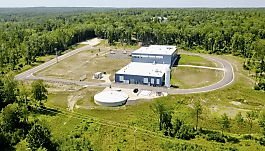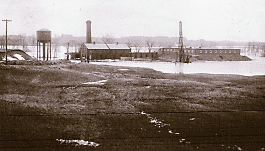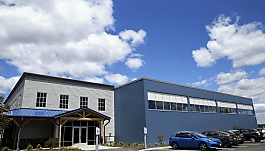Award-winning Maine treatment center embraces sustainability practices
September 7, 2022

AWWA Articles
Award-winning Maine treatment center embraces sustainability practices
At Maine Water’s old Biddeford Water Treatment Plant, operators had to crouch through an old spiral staircase and walk below high-water-flood marks in the hallways.
The plant was built in 1884, before Biddeford had access to electricity, and was last upgraded nearly a century ago.
 When the time finally came to design and build a new facility, Maine Water took the opportunity to emphasize sustainability, relocate it safely away from the flood plain, and preserve 257 acres of surrounding wetlands.
When the time finally came to design and build a new facility, Maine Water took the opportunity to emphasize sustainability, relocate it safely away from the flood plain, and preserve 257 acres of surrounding wetlands.
As a result, the new Saco River Drinking Water Resource Center is New England’s first recipient of the Institute for Sustainable Infrastructure Envision Silver Award.
 “When you look at these kinds of investments from a long-term perspective, it just makes sense to incorporate sustainability,” said Mark Vannoy, president of Maine Water.
“When you look at these kinds of investments from a long-term perspective, it just makes sense to incorporate sustainability,” said Mark Vannoy, president of Maine Water.
In June, after a decade of research, planning and construction, the new treatment facility began operations. It can treat up to 12 million gallons of water a day, serving 40,000 people in the Saco Bay community of southern Maine near the Atlantic Ocean.
 The $60 million project replaced the 138-year-old treatment plant, which was located well within Saco River’s flood plain. It had flooded several times in the past and, because of climate change, was at an increased risk of catastrophic flooding. It also had outdated manually operated equipment, which meant the plant could only treat water when operators were at work. (Pictured right, an historical photo of Biddeford Water Treatment Plant.)
The $60 million project replaced the 138-year-old treatment plant, which was located well within Saco River’s flood plain. It had flooded several times in the past and, because of climate change, was at an increased risk of catastrophic flooding. It also had outdated manually operated equipment, which meant the plant could only treat water when operators were at work. (Pictured right, an historical photo of Biddeford Water Treatment Plant.)
“It shut down at night, started up again the next day, filled up the water tanks in the system and ran throughout the day,” Vannoy said.
The new automated treatment center runs 24 hours a day and has modern equipment, such as space-saving inclined plate settlers and variable-speed pumps.
“It’s a credit to the operators that Maine Water customers didn’t really know there was a risk or impact with the old plant,” said Maureen Westbrook, president of Connecticut Water Service Inc., the New England-based parent company of Maine Water. “But there was a real risk. If you had a flood there, it would impact our ability to serve customers.”
Larger mission for new facility
The new facility is intentionally called a drinking water resource center, rather than a treatment plant, because the name speaks to its larger mission of connecting with the community and highlighting the value of environmental sustainability.
 A 1.1-megawatt solar field will offset 100% of the facility’s power by 2023, and the center is landscaped with native plants, including sugar maple trees, blueberry bushes and witch hazel shrubs.
A 1.1-megawatt solar field will offset 100% of the facility’s power by 2023, and the center is landscaped with native plants, including sugar maple trees, blueberry bushes and witch hazel shrubs.
Several stormwater management and revegetation efforts allow rainwater to slow down and filter through soil before reaching the Saco River. And the utility has preserved 257 acres of surrounding wetlands at the site, which include a red maple swamp and a stream that is crucial habitat for wild brook trout.
“When you walk into the new building, you see a story wall that shows what a precious resource water is,” Westbrook said. “You learn about the professionals who serve the community and you recognize the value in protecting our water resources.”
All critical equipment within the facility is above the 500-year flood elevation or is fully submersible. Structural components are watertight to prevent floodwaters from entering the building, and the raw water intake pipe was placed at the lowest possible point to handle fluctuating Saco River water levels.
 Instead of paying for the new center with one large rate increase, the state’s public utilities commission approved a rate-smoothing method, which allows for three rate increases over three years to help lessen the impact on ratepayers.
Instead of paying for the new center with one large rate increase, the state’s public utilities commission approved a rate-smoothing method, which allows for three rate increases over three years to help lessen the impact on ratepayers.
“The community outreach part is where all projects have to start,” Vannoy said. “Show the value you’re going to deliver. Then it becomes not just a conversation about cost, but a conversation about the value the infrastructure will bring to our customers and the vitality of the community.” (Pictured right, Saco River Drinking Water Resource Center.)
Advertisement